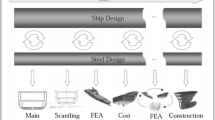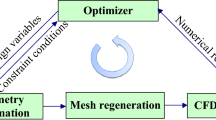Abstract
Knowledge-Based Engineering (KBE) is introduced into the ship structural design in this paper. From the implementation of KBE, the design solutions for both Rules Design Method (RDM) and Interpolation Design Method (IDM) are generated. The corresponding Finite Element (FE) models are generated. Topological design of the longitudinal structures is studied where the Gaussian Process (GP) is employed to build the surrogate model for FE analysis. Multi-objective optimization methods inspired by Pareto Front are used to reduce the design tank weight and outer surface area simultaneously. Additionally, an enhanced Level Set Method (LSM) which employs implicit algorithm is applied to the topological design of typical bracket plate which is used extensively in ship structures. Two different sets of boundary conditions are considered. The proposed methods show satisfactory efficiency and accuracy.
Similar content being viewed by others
References
Alkan, A. D. and Gulez, K., 2004. A knowledge-based computational design tool for determining preliminary stability particulars of naval ships, Nav. Eng. J., 116(4): 37–51.
Allaire, G. and Kohn, R., 1994. Optimal bounds on the effective behavior of a mixture of two well ordered elastic materials, Q. Appl. Math., 51, 643–674.
Allaire, G., Gournay, F. D., Jouve, F. and Toader, A. M., 2004. Structural Optimization Using Topological and Shape Sensitivity via A Level Set Method, Internal Report 555, Ecole Polytechnique, France.
Bichon, B. J., Eldred, M. S., Swiler, L. P., Mahadevan, S. and McFarland, J. M., 2008. Efficient global reliability analysis for nonlinear implicit performance functions, AIAA J., 46(10): 2459–2468.
Chapman, C. B. and Pinfold, M., 2001. The application of a knowledge based engineering approach to the rapid design and analysis of an automotive structure, Adv. Eng. Softw., 32(12): 903–912.
CCS (China Classification Society), 2009. Rules and Regulations for the Construction and Classification of Sea-Going Steel Ships, China Communications Press, Beijing, China. (in Chinese)
Choi, S. K., Grandhi, R. V. and Canfield, R. A., 2007. Reliability-Based Structural Design, 1st ed., Springer.
Cui, J. J., Wang, D. Y., Xia, L. J. and Ma, C., 2012. Mid-ship section structural design and optimization based on knowledge based engineering, Journal of Shanghai Jiaotong University, 46(3): 368–373. (in Chinese)
Cui, J. J. and Wang, D. Y., 2013. Application of knowledge-based engineering in ship structural design and optimization, Ocean Eng., 72, 124–139.
Cui, J. J., Wang, D. Y. and Vlahopoulos, N., 2014. Containership structural design and optimization based on knowledge-based engineering and Gaussian process, Journal of Shanghai Jiaotong University (Science), 19(2): 205–218.
Garreau, S., Guillaume, P. and Masmoudi, M., 2001. The topological asymptotic for PDE systems: The elasticity case, SIAM J. Control Optim., 39(6): 1756–1778.
Helvacioglu, S. and Insel, M., 2003. An expert system approach to container ship layout design, Int. Shipbuild. Prog., 50(1): 19–34.
Jensen, E. D., 1992. Topological Structural Design Using Genetic Algorithms, Ph. D. Thesis, Purdue University.
Kim, T. W., Storch, R. L., Hopman, H. and Erikstad, S. O., 2012. Editorial: Applications in ship and floating structure design and analysis, Comput. Aided Design, 44(3): 163–165.
Kulon, J., Mynors, D. J. and Broomhead, P., 2006. A Knowledge-based engineering design tool for metal forging, J. Mater. Process. Tech., 177(1–3): 331–335.
Lee, D., 2006. Knowledge-based system for safety control of damaged ship, Knowl.-Based Syst., 19(3): 187–191.
Lu, T., Neittaanmaki, T. and Tai, X. C, 1991. A parallel splitting up method and its application to Navier–Stokes equations, Appl. Math. Lett., 4, 25–29.
Luh, G. C., Lin, C. Y. and Lin, Y. S., 2011. A binary particle swarm optimization for continuum structural topology optimization, Appl. Soft Comput., 11, 2833–2844.
Peng, Y. H. and Hu, J., 2007. KBE Technique and Its Application in Production Design, 1st ed., Shanghai Jiao Tong University Press, Shanghai, China. (in Chinese)
Roh, M. H. and Lee, K. Y., 2007. Generation of the 3D CAD model of the hull structure at the initial ship design stage and its application, Comput. Ind., 58(6): 539–557.
Sacks, J., Schiller, S. B., and Welch, W. J., 1989. Designs for computer experiments, Technometrics, 31(1): 41–47.
Sekulski, Z., 2010. Multi-objective topology and size optimization of high-speed vehicle-passenger catamaran structure by genetic algorithm, Mar. Struct., 23, 405–433.
Sharma, R. and Kim, T. W., 2010. Development of a logic-based product life-cycle management (LBPLM) system for shipbuilding industry–Conceptual development, Journal of Ship Production and Design, 26(4): 231–251.
Sharma, R., Kim, T. W., Storch, R. L., and Erikstad, S. O., 2012. Challenges in computer applications for ship and floating structure design and analysis, Comput. Aided Design, 44(3): 166–185.
Shojaee, S. and Mohammadian, M., 2012. Structural topology optimization using an enhanced level set method, Scientia Iranica, 19(5): 1157–1167.
Sokolowski, J. and Zochowski, A., 1999. On the topological derivative in shape optimization, SIAM J. Control Optim., 37(4): 1251–1272.
Sokolowski, J. and Zochowski, A., 2001. Topological derivatives of shape functionals for elasticity systems, Mech. Struct. Mach., 3, 331–349.
Wang, M. Y., Wang, X. M. and Guo, D. M., 2003. A level set method for structural topology optimization, Comput. Method. Appl. M., 192, 227–246.
Zhao, Z., 2002. Research on KBE Technologies for Intelligent Blanking Process Planning Facing Theory and System of Innovative Design, Ph. D. Thesis, Shanghai Jiao Tong University. (in Chinese)
Zhou, X. H., Qiu, Y. and Hua, G., 2007. A feasible approach to the integration of CAD and CAPP, Comput. Aided Design, 39(4): 324–338.
Author information
Authors and Affiliations
Corresponding author
Additional information
This work was financially supported by the Project of Ministry of Education and Finance of China (Grant Nos. 200512 and 201335) and the Project of the State Key Laboratory of Ocean Engineering, Shanghai Jiao Tong University (Grant No. GKZD010053-10).
Rights and permissions
About this article
Cite this article
Cui, Jj., Wang, Dy. & Shi, Qq. Structural topology design of container ship based on knowledge-based engineering and level set method. China Ocean Eng 29, 551–564 (2015). https://doi.org/10.1007/s13344-015-0038-7
Received:
Revised:
Accepted:
Published:
Issue Date:
DOI: https://doi.org/10.1007/s13344-015-0038-7




